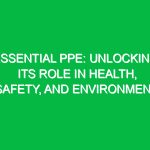Introduction
Personal Protective Equipment (PPE) is a critical component in the Health, Safety, and Environment (HSE) domain. It encompasses a variety of gear designed to protect individuals from health or Safety risks at work. The relevance of PPE in HSE compliance cannot be overstated; it serves as the last line of defense between a worker and potential Hazards. In industries ranging from construction to healthcare, PPE plays a pivotal role in safeguarding employees’ well-being while also ensuring that organizations adhere to stringent Safety Regulations.
Understanding the essential PPE requirements is not just about compliance; it’s about fostering a culture of safety, enhancing productivity, and minimizing risks. As we delve deeper into the specifics of PPE required in various sectors, we aim to provide a comprehensive overview that highlights its significance, associated Hazards, regulatory frameworks, and Best Practices.
Key Aspects of PPE Required in HSE
Types of PPE
PPE can be categorized into several types, each designed to protect against specific hazards. Below are some essential categories relevant to HSE compliance:
- Head Protection: Hard hats and helmets safeguard against falling objects and head injuries, particularly in construction sites.
- Eye and Face Protection: Safety Goggles and face shields are crucial in environments with flying particles, chemical splashes, or radiation.
- Hearing Protection: Earplugs and earmuffs protect against noise-induced hearing loss in industrial settings.
- Respiratory Protection: Masks and respirators guard against inhalation of harmful substances, including dust, fumes, and infectious agents.
- Hand Protection: Gloves made from various materials protect against cuts, burns, chemicals, and biological hazards.
- Foot Protection: Safety boots with steel toes prevent foot injuries from heavy objects and slips.
- Body Protection: Coveralls, vests, and aprons protect against chemicals, heat, and other hazards.
Understanding Hazards and Risks
Identifying the potential hazards is crucial for determining the appropriate PPE required. Hazards can be categorized into three main types: physical, chemical, and biological.
- Physical Hazards: These include falling objects, slippery surfaces, and machinery-related risks. For instance, in construction, the risk of head injuries necessitates the use of hard hats.
- Chemical Hazards: Exposure to chemicals can occur in various industries, including manufacturing and healthcare. PPE like gloves and goggles are essential in such scenarios to prevent skin and eye contact.
- Biological Hazards: In healthcare settings, workers face risks from pathogens. Protective gear such as masks and gowns are necessary to prevent exposure to infectious materials.
Recognizing these hazards allows employers to select the appropriate PPE, ensuring maximum protection for their workforce.
Best Practices for Implementing PPE
Assessment and Selection
Assessing the specific hazards present in the workplace is the first step in determining the PPE required. Employers should conduct a thorough risk assessment to identify potential dangers and the corresponding protective measures needed. The selection process involves choosing PPE that adequately addresses identified risks while ensuring comfort and fit for the user.
For instance, a construction site may require a combination of hard hats, safety goggles, and steel-toed boots. In contrast, a laboratory may necessitate gloves, lab coats, and face shields. Engaging employees in the selection process can also enhance compliance and ensure that the chosen PPE meets their needs.
Training and Education
Proper Training is essential for ensuring that employees understand how to use PPE correctly. This includes instruction on when to wear it, how to maintain it, and the limitations of the equipment. Regular training sessions can refresh knowledge and adaptability, particularly as new equipment or regulations are introduced.
A practical example can be drawn from a manufacturing facility that instituted weekly safety meetings. Employees are reminded of the importance of PPE, leading to a noticeable reduction in workplace injuries.
Regular Maintenance and Inspection
PPE requires regular maintenance and inspection to ensure its effectiveness. Employers should establish a routine for checking the condition of protective gear and replacing items that show signs of wear or damage. For example, respirators need to be cleaned and checked for proper fit to ensure they provide adequate protection.
Organizations should also maintain records of PPE inspections and replacements as part of their safety compliance documentation.
Regulations and Standards Governing PPE
Compliance with regulations and standards is fundamental to effective PPE management. Various organizations and agencies set forth specific guidelines to ensure worker safety.
OSHA Standards
In the United States, the Occupational Safety and Health Administration (osha) provides regulations concerning PPE. Employers are required to conduct hazard assessments and provide appropriate PPE at no cost to employees. OSHA standards also mandate training and maintenance Procedures, ensuring that PPE remains functional and effective.
ANSI and ISO Standards
Organizations such as the American National Standards Institute (ANSI) and the International Organization for Standardization (ISO) develop standards for PPE that ensure quality and safety. For instance, ANSI establishes criteria for eye and face protection, while ISO provides international standards for various types of protective equipment.
The Importance of PPE in Promoting Health, Safety, and Environmental Sustainability
The integration of PPE into Workplace Safety protocols contributes to a culture of health and safety. By prioritizing the well-being of employees, organizations not only comply with regulations but also enhance morale and productivity. A safe work environment fosters trust and loyalty among employees, reducing turnover rates and improving overall job satisfaction.
Furthermore, PPE plays a critical role in environmental sustainability. By preventing accidents and minimizing exposure to hazardous materials, companies can reduce their environmental impact. For instance, using appropriate PPE when handling chemicals reduces the risk of spills, protecting local ecosystems and communities.
Conclusion
In summary, understanding the essential PPE requirements for health, safety, and environment compliance is vital in today’s workplace. From head protection to respiratory safety, the variety of PPE available addresses numerous hazards across different sectors. Implementing Best Practices, ensuring adherence to regulations, and fostering a culture of safety can significantly mitigate risks and protect employees.
As organizations move forward, the commitment to PPE must remain steadfast. By prioritizing the health and safety of their workforce, businesses create a secure environment conducive to productivity and success. Encouraging ongoing conversations about PPE and continuous improvement in safety practices will ultimately lead to a safer and more resilient workplace for everyone involved.


